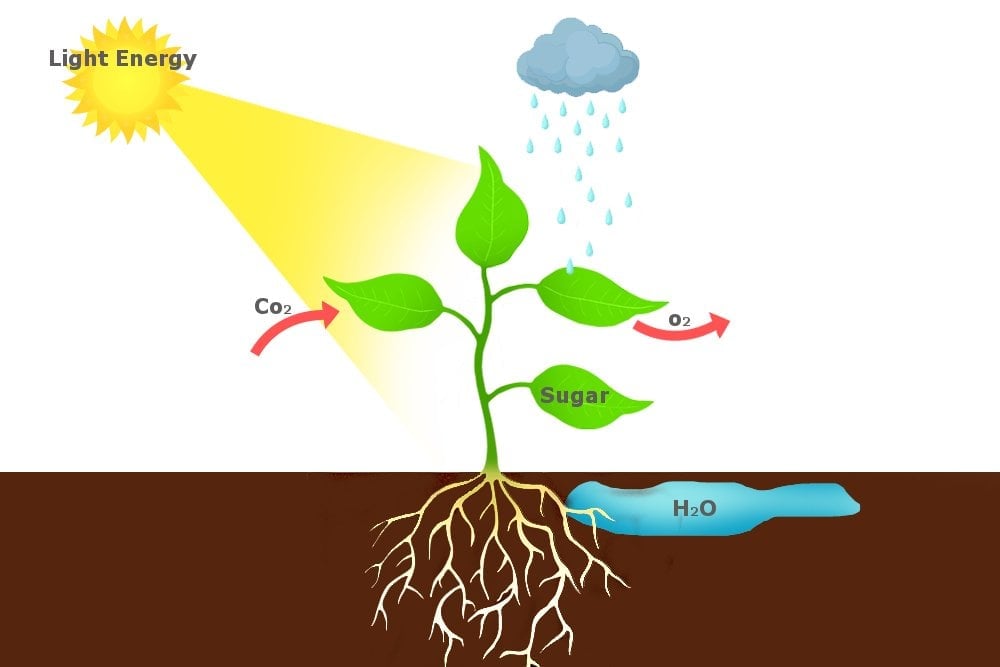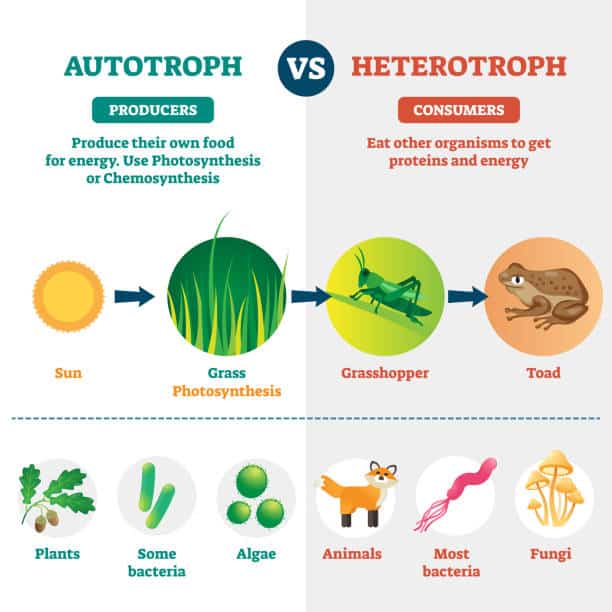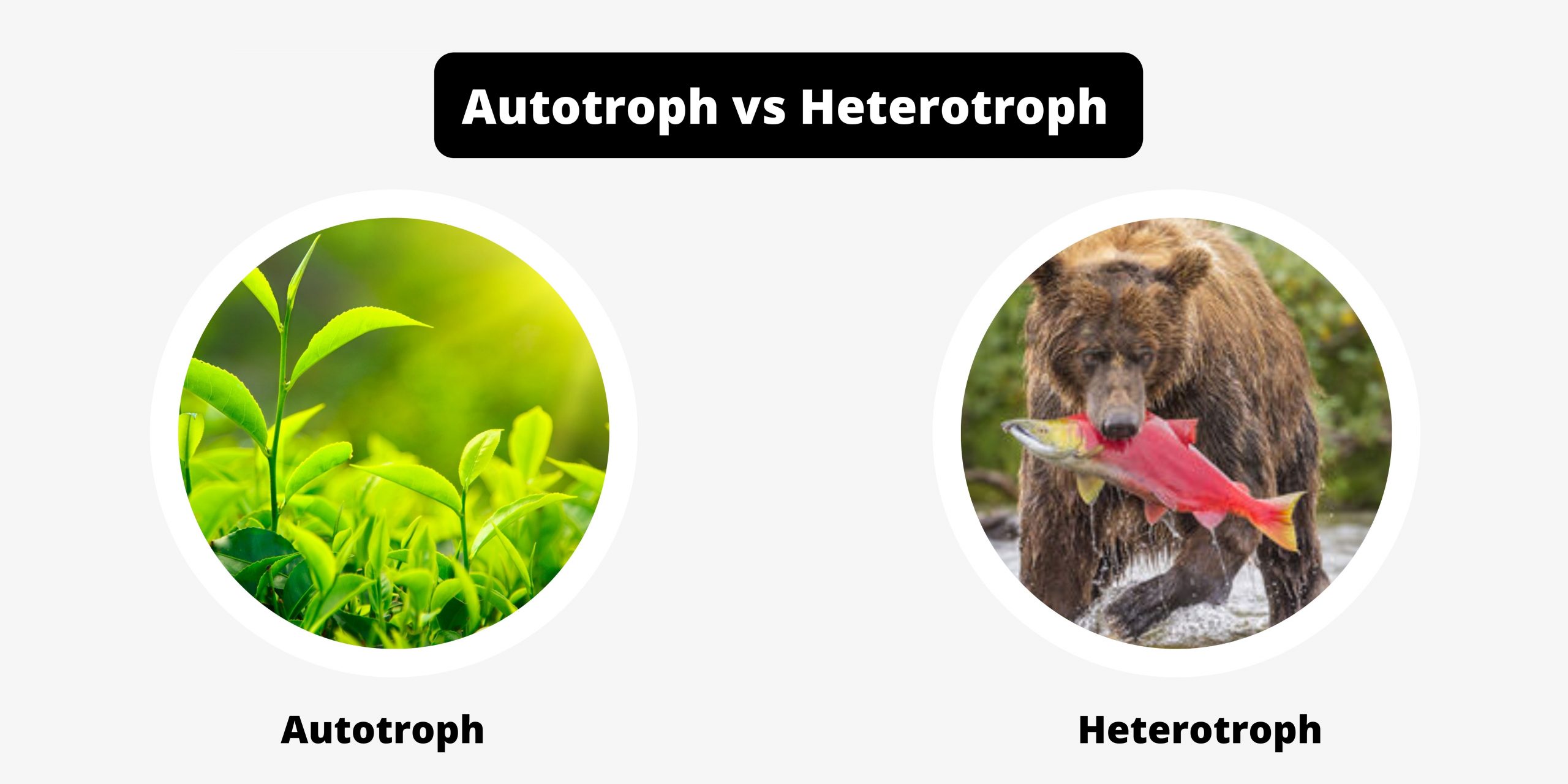Simple non-living chemical reactions. An autotroph or primary producer is an organism that produces complex organic compounds such as carbohydrates fats and proteins using carbon from simple substances such as carbon dioxide generally using energy from light photosynthesis or inorganic chemical reactions chemosynthesis.

Autotroph Definition Classification And Examples
These are the organisms that obtain their energy from sunlight to make organic material.

. Conversely heterotrophs cannot produce their food and they need to eat other organisms. The remaining fixed energy ie mass of photosynthate is referred to as net primary production NPP. Get food by eating other organisms.
Rather than using energy from the sun some will use chemical energy to make their own food. Glucose provides energy to plants. As noted it is equal to the difference between the rate at which the plants in an.
Heterotrophs are further evolved from autotrophs. From this we can say that the first life on earth must be an autotroph. Light into energy stored in organic co.
In conclusion energy in most. They depend on other organisms for both energy and carbon. An autotroph is an organism that can produce its own food using light water carbon dioxide or other chemicalsBecause autotrophs produce their own food they are sometimes called producers.
Autotrophs are self-feeders and they get their energy from non-living sources such as the sun and carbon dioxide. Autotrophs are any organisms that are capable of producing their own food. All autotrophs contain pigmented specialized components which can absorb energy from their environment.
Other eaters do not produce their own food. Autotrophs can generate energy from which of the following. Self-feeders produce their own food.
Autotrophic organisms include both eukaryotic plants and prokaryotic algae organisms. Autotrophs are organisms that can produce their own food using materials from inorganic sources. Which of the following is NOT true regarding the chemical composition of cells.
This can be directly compared to a heterotroph which is incapable of synthesizing these molecules and must consume other organisms. Chemoautotrophs are cells that create their own energy and biological materials from inorganic chemicals. Technically the definition is that autotrophs obtain carbon from inorganic sources.
Autotrophs can generate energy from which of the following. An autotroph is an organism capable of synthesizing energy-bound organic molecules such as sugars using inorganic molecules and an environmental energy source. In contrast heterotrophs are organisms that cannot produce their own nutrients and require consumption of other organisms to live.
Glucose is a sugar that comes in a variety of forms. On the basis of the process of obtaining energy autotrophs are classified into two types they are. Algae which live in water and whose larger forms are known as.
Heterotrophs cannot synthesize their own food and rely on other organisms both plants and animals for nutrition. The most prevalent organic compound is nucleic acids. Most prokaryotes are chemoheterotrophs.
The main difference between autotrophs and heterotrophs is that autotrophs can produce their own food whereas heterotrophs eat other organisms as food. The term autotroph is derived from the basic terms auto and troph which mean self and food respectively. Plants are the most familiar type of autotroph but there are many different kinds of autotrophic organisms.
The autotrophs are known as self feeders that synthesize their own food by the help of the sunlight carbon dioxide by the process known as photosynthesis. In nature autotrophs are organisms that dont need to eat because they make their own biological materials and energy. The word autotroph comes from the root words auto for self and troph for food.
This term comes from the Greek auto for self and troph for to eat or to feed. Autotrophs are important parts of the ecosystem known as producers and they are often the food source for heterotrophs. They convert an abiotic source of energy eg.
Which of the following are explanations for the limited growth during the lag phase. Heterotrophs depend on the suns energy indirectly. They may get energy from light photo or chemical compounds chemo.
They ingest organic substances and break it down into chemical energy. An autotroph is an organism that feeds itself without the assistance of any other organisms. They produce organic substances from inorganic substances by using photosynthesis.
NPP GPP - respiration by plants Net primary production is the rate at which all the autotrophs in an ecosystem produce net useful chemical energy. Autotrophs are called producers because they provide energy and food sources for. All autotrophs use non-living material inorganic sources to make their own food.
Autotrophs are always referred to as primary producers because of their ability to produce their own food and thus occupy the bottom of the food chainIn essence they are the foundation of an ecosystems energy pyramid providing the fuel that all. A _____-troph is an organism that uses the suns light to provide the chemical energy to produce sugar for cellular respiration. Make food from inorganic materials.
Autotrophs utilize the suns energy to transform water from the soil and carbon dioxide from the air into a nutrition called glucose via photosynthesis. They contain pigment known as chlorophyll that traps sunlight to synthesis food by using the energy from the sun and converting the light energy into chemical energy. They may get carbon from carbon dioxide autotroph or other living things heterotroph.
An autotroph is an organism that can produce its own food using inorganic substances. An autotroph can use different energy sources such. Autotrophs are organisms that can produce their own food from the substances available in their surroundings using light photosynthesis or chemical energy chemosynthesis.
Consumption of other organisms Without any energy input Sun light Simple non-living chemical reactions. For most this is achieved by using light energy water and carbon dioxide. Autotrophs are organisms that can produce their own food from solar energy and they are found on the basis of the trophic pyramid.
Many break down organic wastes and the remains of dead organisms. The majority of autotrophs get their food via a process known as photosynthesis.

Autotrophs Examples Types And Meaning Jotscroll

What Is Autotrophic Nutrition Example Of Autotrophs Photosynthesis

Onovni Procesi Zhittyediyalnosti Roslini The Basic Processes Of Plant Life Cellular Respiration Carbon Cycle Plants

0 Comments